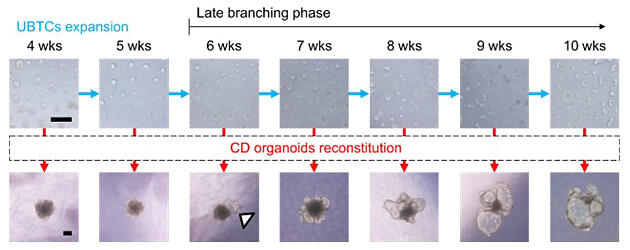A research group led by Program-Specific Research Center Senior Lecturer Shin-Ichi Mae and Professor Kenji Osafune of the Center for iPS Cell Research and Application (CiRA) at Kyoto University announced successful construction of a pathological model of polycystic kidney disease, which is an incurable disease, by creating collecting ducts from induced pluripotent stem (iPS) cells. The group created a model of polycystic kidney disease using renal collecting duct organoids derived from human iPS cells. They successfully discovered therapeutic drug candidates using their constructed model. The results are expected to lead to developments in the elucidation of the disease mechanisms and drug discovery. The results of the study were published in Cell Reports on December 1.

Provided by Kyoto University
In polycystic kidney disease, many fluid-filled sacs (cysts) are formed in the kidneys, leading to declining kidney function. The disease is progressive and incurable. Of the main types of polycystic kidney disease, autosomal dominant polycystic kidney disease (ADPKD) has the highest incidence rate. Cysts form mainly in the collecting ducts, and because of the hereditary condition, numerous cysts develop gradually and grow in size in both kidneys. The condition eventually progresses to renal dysfunction, with ADPKD exhibiting the highest incidence.
In the study, the research group first edited the genome of iPS cells by mutating PKD1, the gene that causes ADPKD. They then used the genome-edited iPS cells to generate collecting duct organoids. In this way, they constructed a model of ADPKD with cyst formation in collecting ducts.
When tolvaptan, which is a drug for ADPKD treatment, was applied to these collecting duct organoids, the size of the cysts decreased. The research group also used the collecting duct organoid-based ADPKD model to establish a screening system that can measure the effects of 96 drugs at once. Using this screening system, the group demonstrated that the size enlargement of cysts could be suppressed by treatment with the potent retinoic acid receptor (RAR) agonists TTNPB and all-trans retinoic acid (ATRA), which is already being clinically used for the treatment of patients with acute promyelocytic leukemia (APL).
The research group investigated whether ATRA was effective in a mouse model of ADPKD. The results suggested that this drug had a therapeutic effect in suppressing cyst formation and renal dysfunction exacerbation in both in vivo and in vitro ADPKD models. Rege Nephro Co., Ltd. will soon begin clinical trials of the drug candidates found thus far.
Osafune said, "This is the research that I have been working on for over 15 years since I started my laboratory. I will soon begin clinical trials to confirm the safety and effectiveness of the new drug candidates discovered at this time. I will also continue my research using iPS cells to find new useful treatments for patients with various intractable diseases, including polycystic kidney disease."
Journal Information
Publication: Cell Reports
Title: Human iPSC-derived renal collecting duct organoid model cystogenesis in ADPKD
DOI: 10.1016/j.celrep.2023.113431
This article has been translated by JST with permission from The Science News Ltd. (https://sci-news.co.jp/). Unauthorized reproduction of the article and photographs is prohibited.




